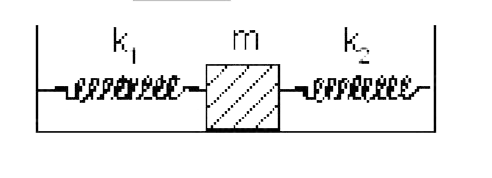If T1andT2 are the time of oscillations for two springs of constants k1andk2 connected to the mass m individually then calculate the time period of oscillations when both the spring are connected to the same mass and subjected to oscillations.Solution in Kannada
For two springs supporting the mass body,
k=k1+k2
but T=2π√mK.
so that k=4π2mT2
i.e. k=4π2mT21+4π2mT22.
i.e. 1T2=1T21+1T22
or T−2=T−21+T−22.
Topper's Solved these Questions
- OSCILLATIONSBOOK - SUBHASH PUBLICATIONCHAPTER - OSCILLATIONSEXERCISE - FIVE MARKS QUESTIONS WITH ANSWERS
4 Videos
- MOTION IN PLANEBOOK - SUBHASH PUBLICATIONCHAPTER - MOTION IN PLANEEXERCISE - NUMERICALS WITH SOLUTIONS
47 Videos
- PHYSICAL WORLDBOOK - SUBHASH PUBLICATIONCHAPTER - PHYSICAL WORLDEXERCISE - TWO MARKS QUESTIONS WITH ANSWERS
30 Videos
Similar Questions
Arrive an expression for time period of simple pendulum.
View SolutionTwo forces 8N and 5N are acting at a point on a body at an angle 120∘ then find the (i) magnitude and (ii) direction of their resultant.
View SolutionMathematics is the language of physics. Justify the statement.
View SolutionTwo springs are made to oscillate simple harmonically due to the same mass individually. The time periods obtained are T1 and T2. If both the springs are connected in series and hten made to oscillate by the same mass, the resulting time period will be
View SolutionT1,T2 are time periods of oscillation of a block when individually suspended to springs of force constants K1,K2 respectively. If same block is suspended to series combination of same two springs, then it time period of oscillation.
View SolutionT_(1),T_(2) are time periods of oscillation of a block when individually suspended to springs of force constants K_(1),K_(2) respectively. If same block is suspended to parallel combination fo same two springs. Its time period is
View SolutionA mass is suspended separately by two springs of spring constants k1 and k2 in successive order. The time periods of oscillations in the two cases are T1 and T2 respectively. If the same mass be suspended by connecting the two springs in parallel, (as shown in figure) then the time period of oscillations is T. The correct relations is

View SolutionPeriodic time of oscillation T1 is obtained when a mass is suspended from a spring and if another spring is used with same mass then periodic time of oscillation is T2 . Now if this mass is suspended from series combination of above springs then calculated the time period.
View SolutionWhen a block of mass m is suspended separately by two different springs have time period t1 and t2. If same mass is connected to parallel combination of both springs, then its time period is given by :-
View SolutionTwo springs of force constants K_(1) " and " K_(2) are connected to a mass m as shown I the figure. If both K_(1) " and " K_(2) are made four times their original values, the frequency of oscillation becomes,
View SolutionA block of mass m is connected between two springs (constants K1 and K2) as shown in the figure and is made to oscillate, the frequency of oscillation of the system shall be-

View SolutionThe time period of oscillations of a block attached to a spring is t_(1) . When the spring is replaced by another spring, the time period of the block is t_(2) . If both the springs are connected in series and the block is made to oscillate using the combination, then the time period of the block is
View SolutionTwo weightless springs have force constants k_(1) and k_(2) and connected in series. The combination is loaded with m, the time period of oscillation is :
View SolutionA Body of mass (m) is suspended from two light springs of spring constants k_(1) and k_(2) (lt k_(1)) separately.The periods of vertical oscillations are T_(1) and T_(2) respectively. Now the same body is suspended from same two springs which are first connected in series and then in parallel. The period of vertical oscillations are T_(S) and T_(P) respectively.
View SolutionTwo spring of spring constants k_(1) and k_(2) ar joined and are connected to a mass m as shown in the figure. Calculate the frequency of oscillation of mass m.
View Solution
